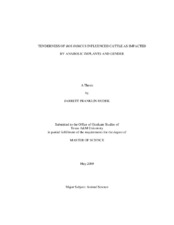| dc.description.abstract | Steers (n = 77) and heifers (n = 68) were assigned randomly to one of three
treatment groups. Treatment groups were defined as: no implant, implanted twice with
trenbolone acetate (Revalor S or H), or implanted twice with estrodial benzoate
(Synovex S or H). Animals were fed to an estimated 10 mm backfat thickness and based
on visual appraisal, were assigned a harvest date. Carcass characteristics, color space
values, sarcomere length, fat and moisture determination, Warner-Bratzler shear force,
and protein degradation were all measured. Implanted animals, as a whole, exhibited
heavier hot carcass weights and larger ribeye areas than non-implanted animals.
Animals implanted with Revalor displayed significantly lower marbling scores and
lower yield grades than those from control or Synovex groups. The distribution of
quality grades within treatment groups shifted, with implant groups displaying higher
percentages of Select carcasses. Gender impacted percentage of extractable fat and
marbling scores, with heifers displaying higher values than steers for both
measurements. Both implant groups displayed higher (P < 0.05) Warner-Bratzler shear
values following a 0- and 14-d aging periods. However, following the 21-d aging period, differences in tenderness were no longer present between non-implanted and
implanted animals. Synovex treated animals displayed longer (P < 0.01) sarcomere
lengths than control or Revalor. Differences (P < 0.001) in protein degradation were
found between treatment groups. Across gender groups, the non-implanted cattle
displayed the greatest amount of degradation (62%), followed by Synovex (48%,) and
lastly Revalor (33%), all of which were different (P < .05) from each other.
These results indicate that use of anabolic implants positively impacted lean
muscle growth, yet was a detriment to quality. Also, tenderness was negatively
impacted by the use of these compounds. However, this study found by aging product
for at least 21 days, tenderness differences between implanted and non-implanted
animals were significantly mitigated. | en |


